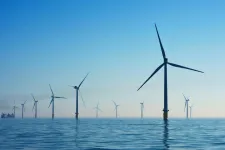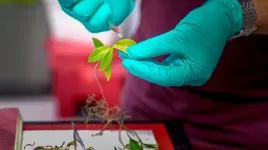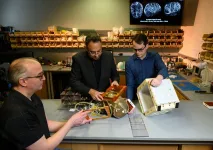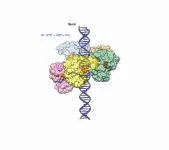Are wind farms slowing each other down?
If the offshore wind turbines are too numerous, they will produce less power; this should be considered when planning the farms
2021-06-03
(Press-News.org) The expansion of wind energy in the German Bight and the Baltic Sea has accelerated enormously in recent years. The first systems went into operation in 2008. Today, wind turbines with an output of around 8,000 megawatts rotate in German waters, which corresponds to around eight nuclear power plants. But space is limited. For this reason, wind farms are sometimes built very close to one another. A team led by Dr. Naveed Akhtar from Helmholtz Zentrum Hereon has found that wind speeds at the downstream windfarm are significantly slowed down. As the researchers now write in the journal Nature Scientific Reports, this braking effect results in astonishingly large-scale low wind pattern noticeable in mean wind speeds. On average, they extend 35 to 40 kilometers - in certain weather conditions even up to 100 kilometers. The output of a neighboring wind farm can thus be reduced by 20 to 25 percent, which ultimately leads to economic consequences. If wind farms are planned close together, this wake effects need to be considered in the future.
Combination of climate and wind farm data
With their study, Naveed Akhtar, an expert in regional climate modeling, and his colleagues took a look into the future and assessed the wind characteristics for a medium-term target state of offshore expansion. They used the computer model COSMO-CLM, which is also used by weather services and which is able to resolve weather situations regionally in detail - in this case for the entire North Sea and combined it with the future wind farm characteristic - their area and the number and size of the turbines. They used the wind farm planning for the North Sea from 2015 as a basis. This contains wind farms, some of which have not yet been built.
Braking effect especially in stable weather conditions
Naveed Akhtar used the COSMO model to calculate the wind speed over the North Sea for the period from 2008 to 2017 covering a range of different weather conditions. The results clearly show that we will face a large scale pattern of reduced wind speed, which show largest extensions during stable weather conditions, typically the case in March and April. In stormy times, on the other hand - especially in November and December - the atmosphere is so mixed that the wind farm wake effects are relatively small. In order to verify the model data, the team compared the simulations with wind measurements from 2008 to 2017. They used measurements that were recorded on two research platforms in the North Sea and data from wind measurement flights that colleagues from the TU Braunschweig performed over existing wind farms. The comparison shows that the Hereon researchers are correctly simulating the wind wakes. What is special about the work is that for the first time a full ten-year period has been calculated for the entire North Sea. "Conventional flow models for analyzing wind farms have a very high spatial resolution, but only look at a wind field over a short period of time," says Akhtar. "In addition, these cannot be used to determine how a wind farm changes the air flow over a large area."
While the group has mainly dealt with the extent to which the wind farms influence each other in their current work, they intend to investigate in the near future what influence the reduced wind speeds have on life in the sea. Wind and waves mix the sea. This changes the salt and oxygen content of the water, its temperature and the amount of nutrients in certain water depths. Naveed Akhtar: "We would now like to find out how the reduced mixing affects the marine ecosystem."
INFORMATION:
[Attachments] See images for this press release:

ELSE PRESS RELEASES FROM THIS DATE:
2021-06-03
Neurodegenerative disorders that cause dementia increase the risk of contracting severe COVID-19 and dying from the disease. For people with Alzheimer's the risk is three times greater. It can be six times greater if they are over 80, according to a study conducted in Brazil by researchers at the University of São Paulo (USP) and Butantan Institute in partnership with colleagues at the Federal University of Rio de Janeiro (UFRJ).
An article on the study, which was supported by FAPESP, is published in Alzheimer's & Dementia: The Journal of the Alzheimer's Association.
"We found that all causes of dementia are risk factors for severity and death in COVID-19 and that these ...
2021-06-03
ITHACA, N.Y. - Water regulation in leaves is vital to a plant's health, affecting its growth and yield, disease susceptibility and drought resistance.
A breakthrough technology developed by Cornell University researchers uses nanoscale sensors and fiber optics to measure water status just inside a leaf's surface, where water in plants is most actively managed.
The engineering feat provides a minimally invasive research tool that will greatly advance the understanding of basic plant biology, and opens the door for breeding more drought-resistant crops. The technology could eventually be adapted for use as an agronomic tool for measuring water status in crops in real time.
The study in maize plants, "A Minimally Disruptive Method for Measuring Water Potential In-Planta ...
2021-06-03
Sickle Cell Disease (SCD) is a genetically inherited group of red blood cell disorders. END ...
2021-06-03
DURHAM, N.C. - A group of researchers have discovered the detailed inner workings of the molecular motor that packages genetic material into double-stranded DNA viruses. The advance provides insight into a critical step in the reproduction cycle of viruses such as pox- herpes- and adeno-viruses. It could also give inspiration to researchers creating microscopic machines based on naturally occurring biomotors.
The research was conducted by scientists from Duke University, the University of Minnesota, the University of Massachusetts and the University of Texas Medical Branch (UTMB). The results appear online in a trilogy of papers published in Science Advances, ...
2021-06-03
WHO: JoAnn Manson, MD, DrPH, Physician and Epidemiologist, Division of Preventive Medicine, Brigham and Women's Hospital; co-author of a new Perspective piece published in The New England Journal of Medicine (pdf attached)
WHAT: Less than 50 years ago, a U.S. Supreme Court decision paved the way for women's use of contraception irrespective of marital status, and a year later, in 1973, the Court ruled in Roe v. Wade that women have a right to legalized abortion. In recent decades, clinical researchers and policymakers alike have made important strides ...
2021-06-03
You would not be surprised to see an elephant in the savanna or a plate in your kitchen. Based on your prior experiences and knowledge, you know that is where elephants and plates are often to be found. If you saw a mysterious object in your kitchen, how would you figure out what it was? You would rely on your expectations or prior knowledge. Should a computer approach the problem in the same way? The answer may surprise you. Cold Spring Harbor Laboratory Professor Partha Mitra described how he views problems like these in a "Perspective" in Nature Machine Intelligence. He hopes his insights will help researchers teach computers how to analyze complex systems more effectively.
Mitra thinks it helps to understand the nature of knowledge. Mathematically speaking, many data scientists ...
2021-06-03
The surface of the sun churns with energy and frequently ejects masses of highly-magnetized plasma towards Earth. Sometimes these ejections are strong enough to crash through the magnetosphere -- the natural magnetic shield that protects the Earth -- damaging satellites or electrical grids. Such space weather events can be catastrophic.
Astronomers have studied the sun's activity for centuries with greater and greater understanding. Today, computers are central to the quest to understand the sun's behavior and its role in space weather events.
The ...
2021-06-03
MADISON, Wis. -- For birds and other wildlife, winter is a time of resource scarcity. Extreme winter weather events such as a polar vortex can push some species to the edge of survival. Yet winter tends to get short shrift in climate change research, according to UW-Madison forest and wildlife ecology Professor Ben Zuckerberg.
"When we think about the impact of climate change, winter tends to be overlooked as a time of year that could have significant ecological and biological implications," says Zuckerberg. "It makes me, and my colleagues, think quite deeply about the impacts of these extreme events during this time when species are particularly vulnerable."
Zuckerberg, ...
2021-06-03
Using a piece of magnet, researchers have designed a simple system that can control the movement of a small puddle of water, even when it's upside down. The new liquid manipulation strategy, described in the journal Cell Reports Physical Science on June 3, can have a wide range of applications including cleaning hard-to-reach environments or delivering small objects.
Previous attempts to control the movement of fluids often relied on special platforms. For example, on a surface that has one section more hydrophobic than another, water will spontaneously ...
2021-06-03
Anyone that's ever interacted with a dog knows that they often have an amazing capacity to interact with people. Now researchers reporting in the journal Current Biology on June 3 have found that this ability is present in dogs from a very young age and doesn't require much, if any, prior experience or training. But, some of them start off better at it than others based on their genetics.
"We show that puppies will reciprocate human social gaze and successfully use information given by a human in a social context from a very young age and prior to extensive experience with humans," said Emily E. Bray of the University of Arizona, Tucson. "For example, even before puppies have left their littermates to live ...
LAST 30 PRESS RELEASES:
[Press-News.org] Are wind farms slowing each other down?
If the offshore wind turbines are too numerous, they will produce less power; this should be considered when planning the farms






